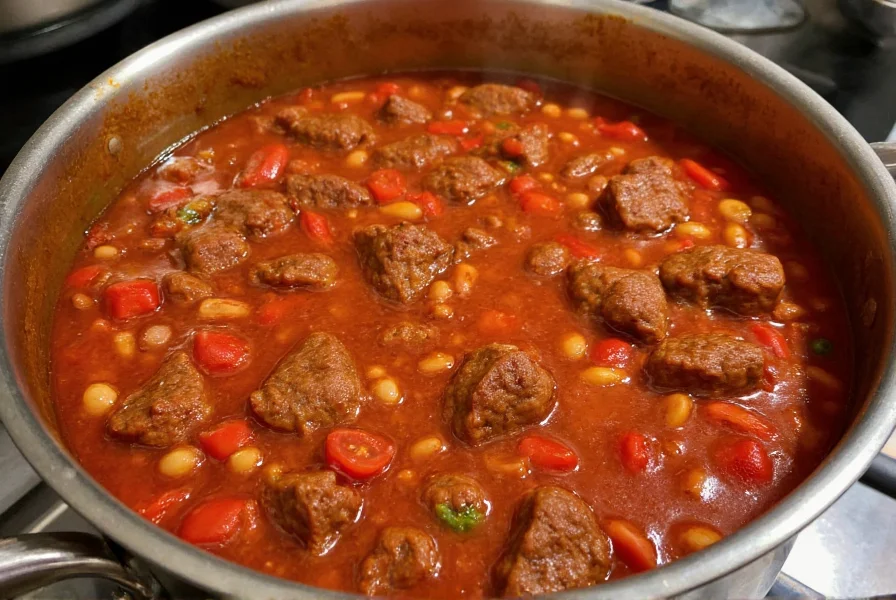Understanding the precise definition for chili requires recognizing its dual culinary identities. This distinction prevents confusion in recipes, menus, and cultural discussions about this globally significant food element.
Chili Peppers: The Botanical Definition
Chili peppers (sometimes spelled chilli or chile) belong to the Capsicum genus within the nightshade family. These fruits contain capsaicin, the compound responsible for their heat. The Scoville scale measures their spiciness, ranging from:
| Pepper Type | Scoville Heat Units | Common Uses |
|---|---|---|
| Bell Pepper | 0 SHU | Salads, stuffed dishes |
| Jalapeño | 2,500–8,000 SHU | Salsas, nachos |
| Habanero | 100,000–350,000 SHU | Hot sauces, Caribbean cuisine |
| Carolina Reaper | 1,400,000–2,200,000 SHU | Extreme heat challenges |
Over 30 types of chili peppers exist worldwide, each contributing unique flavor profiles beyond mere heat. The term definition of chili pepper encompasses both fresh varieties like serranos and dried forms like ancho or chipotle peppers, which develop deeper, smokier flavors through dehydration.

Chili Con Carne: The Culinary Dish
When Americans say chili without qualification, they typically mean chili con carne (Spanish for "chili with meat"). This Tex-Mex stew features:
- Ground beef or cubed meat as the protein base
- Beans (though traditional Texas-style often omits them)
- Tomatoes or tomato paste
- Multiple chili pepper varieties for layered heat
- Warming spices like cumin and oregano
The chili con carne definition has evolved significantly since its 19th century origins along the Texas-Mexico border. Modern interpretations range from meat-heavy "bowl of red" versions to vegetarian adaptations using mushrooms or lentils. The dish gained international recognition after winning first prize at the 1937 Texas State Fair.
Linguistic Origins and Regional Variations
The word chili derives from the Náhuatl (Aztec) word chīlli, referring to the spicy peppers native to Mesoamerica. Spanish colonists adapted this as chile, which entered English through Mexican-American communities.
Spelling variations create additional confusion:
- Chili - Most common American spelling for both pepper and dish
- Chilli - Preferred British English spelling
- Chile - Correct Spanish spelling, also refers to the country
Understanding the origin of the word chili helps explain why context determines meaning. In grocery stores, "chili" typically means the prepared dish or canned chili beans, while "chili peppers" specifies the fresh or dried spice.
Common Misconceptions Clarified
Several persistent myths surround chili meaning in cooking:
- Myth: All chili peppers are extremely hot
Fact: Bell peppers are technically chili peppers with zero heat - Myth: Chili powder contains only one pepper type
Fact: Most commercial blends combine ancho, cayenne, and other peppers - Myth: Authentic chili never contains beans
Fact: Bean inclusion varies by regional tradition, not authenticity

Practical Usage Guidelines
To avoid confusion when discussing or searching for chili definition information:
- Specify chili peppers when referring to the spice ingredient
- Use chili con carne or chili stew for the dish
- Include regional context (e.g., "Texas chili" vs. "Cincinnati chili")
- When searching online, add clarifying terms like pepper or recipe
Professional chefs and culinary writers increasingly use precise terminology to distinguish between these concepts, recognizing that clear communication enhances both cooking and cultural understanding.
Frequently Asked Questions
What's the difference between chili and chilli?
Both spellings refer to the same concept. 'Chili' is the predominant American English spelling for both the peppers and the dish. 'Chilli' is the preferred British English spelling. The Spanish spelling 'chile' refers specifically to the peppers and is also the name of the South American country.
Is chili powder the same as chili peppers?
No. Chili powder is a spice blend typically containing ground chili peppers plus other ingredients like cumin, garlic powder, and oregano. Pure ground chili peppers are labeled as 'crushed red pepper' or specify the pepper variety (e.g., 'ancho chili powder').
Why does the meaning of 'chili' change based on context?
Language evolves through usage. In American English, 'chili' as a standalone term became associated with the popular dish 'chili con carne' through cultural adoption, while 'chili peppers' specifies the ingredient. This contextual distinction developed naturally as the food became mainstream.
Does authentic chili always contain beans?
No single 'authentic' version exists. Traditional Texas-style chili often omits beans, focusing on meat and chili peppers. Many other regional variations throughout the American Southwest and Mexico include beans. Both approaches have historical roots in different culinary traditions.
How did chili peppers spread globally from the Americas?
After Christopher Columbus brought chili peppers to Europe in 1493, Portuguese traders distributed them throughout Africa and Asia. By the 16th century, chili peppers had integrated into cuisines across India, Thailand, Hungary, and beyond, adapting to local culinary traditions while maintaining their distinctive heat.











 浙公网安备
33010002000092号
浙公网安备
33010002000092号 浙B2-20120091-4
浙B2-20120091-4